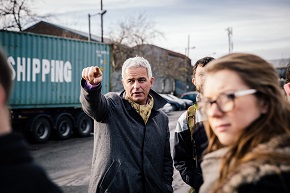Putting the empathy back in architecture
When it came to designing U+I's offices at Howick Place, we gave our architects a simple – but unique – brief: a video tape of the film 'Charlie and the Chocolate Factory'. Of course, we gave them all the technical details they needed as well, but this emotional brief was just as important. It conveyed the sense of childlike wonder we wanted to create when people walk through our doors, the sense of possibility that awaits at the start of every new project.
This emotional brief – and its response – is what’s missing from so many of the presentations I see from architects. In too many schemes today, design, curiosity and imagination give way to process and prestige. All too often when architects give presentations, their first slide will be a picture of a group of them, all looking like a democracy. Then there is a list of awards they have won. Then they will go through education, housing, commerce, with pictures of buildings. There is no philosophy, there is very little empathy and understanding of what the customer needs.
To me, architecture isn’t just about the technical brilliance or the awards won. It’s about the feel of a place. The areas where U+I works are often overlooked, deprived, derelict spaces. There are social problems that we need to overcome if we’re to create somewhere with lasting potential and value.
Design is just one of the many tools we use to fix what is broken and create somewhere everyone can be proud of. Take Deptford Market Yard. Our development there wasn’t just about a beautiful design that restored the railway arches to their former glory. It was about using those restored arches to create spaces where local businesses can thrive. The design was not the end in itself, but the means to reconnect people and place.
The Dutch architect Rem Koolhaas once went to view some architectural students’ work. When he arrived, he told them to either show him art, or politics. As developers, our art – our politics, even – is making beautiful spaces that are inclusive and thoughtful for all. If architecture is to fix what’s broken, then it needs to start with an understanding of the context in which it is operating. It needs to get under the skin of the community that will use what is being built.
This is something we seek to do in every one of our projects at U+I. In Deptford, for example, we spent time at the site while we worked on our plans. We got to know the local community there, talked to them about what they wanted and needed. We moved an old railway carriage onto the site, creating a meeting point for locals, and we opened up the derelict railway arches to local traders. Some of those traders went on to take permanent space in the refurbished arches. Today, Deptford Market Yard is a thriving hub of independent shops and restaurants, and a new weekly food market is bringing people flocking to the area for something unique.
Having nice buildings is a small part of what goes into creating these beautiful, thoughtful spaces. Perhaps it’s best illustrated by thinking about one of the oldest community spaces of them all: the local pub. When I go to a pub, I want a pint and some pork scratchings. But I also want atmosphere. The architect very regularly talks about technical competence like a pub talks about a pint and pork scratchings.
What’s missing is the service and care that will make my experience memorable. It’s when that emotional connection happens – when developers and architects think about more than just the pint and pork scratchings and respond to the context and community they’re working in – that a place becomes truly special.
This article was originally published on 2 August 2018 by U+I. It was written by Richard Upton.
--U and I
[edit] Related articles on Designing Buildings Wiki
Featured articles and news
Retired firefighter cycles world to raise Grenfell funds
Leaving on 14 June 2025 Stephen will raise money for youth and schools through the Grenfell Foundation.
Key points for construction at a glance with industry reactions.
Functionality, visibility and sustainability
The simpler approach to specification.
Architects, architecture, buildings, and inspiration in film
The close ties between makers and the movies, with our long list of suggested viewing.
SELECT three-point plan for action issued to MSPs
Call for Scottish regulation, green skills and recognition of electrotechnical industry as part of a manifesto for Scottish Parliamentary elections.
UCEM becomes the University of the Built Environment
Major milestone in its 106-year history, follows recent merger with London School of Architecture (LSE).
Professional practical experience for Architects in training
The long process to transform the nature of education and professional practical experience in the Architecture profession following recent reports.
A people-first approach to retrofit
Moving away from the destructive paradigm of fabric-first.
International Electrician Day, 10 June 2025
Celebrating the role of electrical engineers from André-Marie Amperè, today and for the future.
New guide for clients launched at Houses of Parliament
'There has never been a more important time for clients to step up and ...ask the right questions'
The impact of recycled slate tiles
Innovation across the decades.
EPC changes for existing buildings
Changes and their context as the new RdSAP methodology comes into use from 15 June.
Skills England publishes Sector skills needs assessments
Priority areas relating to the built environment highlighted and described in brief.
BSRIA HVAC Market Watch - May 2025 Edition
Heat Pump Market Outlook: Policy, Performance & Refrigerant Trends for 2025–2028.
Committing to EDI in construction with CIOB
Built Environment professional bodies deepen commitment to EDI with two new signatories: CIAT and CICES.
Government Grenfell progress report at a glance
Line by line recomendation overview, with links to more details.
An engaging and lively review of his professional life.
Sustainable heating for listed buildings
A problem that needs to be approached intelligently.
50th Golden anniversary ECA Edmundson apprentice award
Deadline for entries has been extended to Friday 27 June, so don't miss out!
CIAT at the London Festival of Architecture
Designing for Everyone: Breaking Barriers in Inclusive Architecture.
Mixed reactions to apprenticeship and skills reform 2025
A 'welcome shift' for some and a 'backwards step' for others.





























